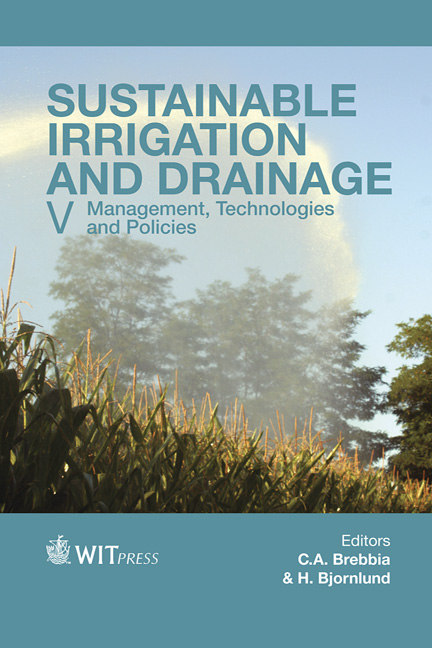The Effects Of Different Levels Of Irrigation Water Salinity And Leaching On The Amount And Distribution Pattern Of Soil Salinity And Ions In An Arid Region
Price
Free (open access)
Transaction
Volume
185
Pages
11
Page Range
33 - 43
Published
2014
Size
482 kb
Paper DOI
10.2495/SI140041
Copyright
WIT Press
Author(s)
H. Mansouri, B. Mostafazadeh-Fard, A. Neekabadi
Abstract
Soil salinity is a major environmental factor limiting the productivity of agricultural lands. To determine the effects of irrigation water salinity and leaching on soil salinity and ion concentrations, a field experiment was conducted on a silty-clay soil (a typical soil of the Rudasht region, Isfahan province, Iran). The experiment consisted of three irrigation water salinity levels (2, 8, and 12 dS/m) with/without leaching levels of 4, 19, and 32% under two irrigation water management scenarios. Using factorial design, four replications for each treatment were used. The results showed that as the irrigation water salinity increased, the EC (Electrical Conductivity), CO32− (Carbon Trioxide), Cl− (Chlorine), SO42+ (Sulphate), Ca (Calcium), Mg (Magnesium) and Na (Sodium) concentrations in the soil decreased significantly. The minimum and maximum values of soil salinity were 4.2 and 9.4 dS/m, respectively. Irrigation management decreased salinity and soil ions and leaching decreased the amount of Cl−, SO42+ and Na in soil but only the effect of irrigation management was significant in decreasing CO32−, Cl− and Na values. Irrigation management was more effective than leaching in decreasing ions. As the irrigation water salinity increased, soil moisture content increased and leaching reduced soil salinity. In treatments which were irrigated with 2 dS/m water, soil salinity increased with depth. In treatments which were irrigated by 8 dS/m water, soil salinity increased to the depth of 30 cm, decreased to the depth of 60 cm and then remained constant. In treatments which wereirrigated by 12 dS/m water, soil salinity increased to the depth of 30 cm and then decreased. Effects of irrigation water management and leaching on salt removal from soil was higher for the top soil layer as compared to the lower layers of soil. Under leaching, more salts were accumulated at the lower depths of soil. The distribution pattern of different ions was drawn by using measured data. Then the results were simulated by a calibrated SWAP (Soil, Water, Atmosphere and Plant) model. The R-squared value showed that SWAP is usable to predict soil salinity and ion amounts. This should allow users to examine efforts aimed at sustainable agricultural production and profitable yield in arid regions.
Keywords
irrigation management, soil salinity, ion, distribution pattern





